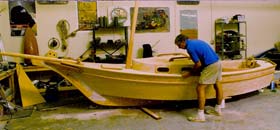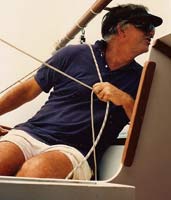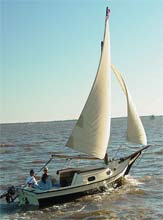After five months of work, I’m getting to know my boat. What began as a set of plans and a dozen sheets of plywood is now taking shape and gaining some personality. It’s not just any Pocket Cruiser; it’s my Pocket Cruiser and while hundreds have been built around the world, none looks exactly like the one in my garage. Spend time with my boat and you’ll know a little bit more about me.
But as time passes, I’m also getting to know more about a man named Pete Stevenson. He lives two thousand miles away and we’ve never met, but as the designer of my Pocket Cruiser, it’s his boat too, and his personality and skills made the boat possible. I tinker on the margins, but he’s the Creator. Without Pete, I wouldn’t have a boat.
 |
As time passes, I’m getting to know more about a man named Pete Stevenson. As the designer of my Pocket Cruiser, it’s his boat too, and his personality and skills made the boat possible. |
There’s an odd relationship between designers and builders. We are partners, but also strangers. For some builders there is an undercurrent of mistrust and a powerful temptation to second guess the designer by making modifications and improvements—which sometimes work, and sometimes don’t.
Designers, meanwhile, send their creations out into the world and wait anxiously for the results. What did I forget to tell people? Will it sail under difficult conditions? At the same time, I think they might also wonder why some builders refuse to follow the plans. If you really wanted a twenty-foot boat, why did you buy plans for a fifteen-foot boat? And, for crying out loud, I put the centerboard there for a reason!
Like any relationship, I think it’s important to choose a boat and, by extension, a designer that reflects your own personality and expectations.
One thing I like about Stevenson’s boat plans is that they come with detailed narrative, which not only explains what I need to do next but, occasionally, imparts a small doses of Pete’s boat building philosophy. He also sells a DVD chronicling the construction of the Weekender, his first pocket yacht and one of his most popular designs. While the focus is on the “how-to” of building, I have gleaned a few insights about his personality while watching him measure, cut and glue.
I get the clear impression, for example, that Pete isn’t a perfectionist. Don’t waste time polishing parts that won’t show, he suggests; don’t worry about small mistakes; don’t waste money. His on-camera demeanor is low key, self-deprecating, a bit laconic. I like the guy. I think it would be fun to have a beer with him. I think we are a good match.
But as I get deeper into my project, I found myself wanting to know even more about the origins of my boat and the intentions of its designer. I also wondered what Pete thought about the small controversies that surround his boats. And amid all the conflicting advice I get about the right kind of materials and methods, could he clear the air and show me the true path to boat building enlightenment?
Pete is quite willing to talk about his experiences as a designer. His Web site includes a short essay on the development of the Weekender and he lets people know that his skills are largely self-taught. Without much elaboration, he explains that he arrived at boat building not as an engineer, but as a surfer. But that left a lot of questions unanswered, so in a series of emails, Pete cheerfully filled in the gaps and answered all of my burning questions.
So how did a surfer dude become a boat designer in the first place? “Surfing's a good way to build an instinct for how solid shapes will be affected by water movement,” he said. “You're right there in the water, up close and personal, experiencing every way the fluid bounces off the shape and pushes it.”
But his first attempt at boat design was a total disaster. He built an outrigger from one sheet of plywood and a chopped down telephone pole. Fortunately, he wasn’t on board when the whole thing disintegrated.
“A couple of thugs paddled over and demanded to take the first test ride. We had no choice but swim in and watch what was supposed to be our fun. But then a thin white line of soup on the horizon announced what we used to call a "clean-up wave.” We watched with ill concealed glee as the big guys took gas in the rinse cycle. The remaining parts were so heavy we left them for bonfire fodder. We learned about ‘building light’ from that.”
| Pete sells a DVD chronicling the construction of the Weekender, his first pocket yacht and one of his most popular designs. |
 |
The next attempt was more successful, although it was simply the result of playful experimentation. “A number of guys would gather to down beers and argue about boat design. During one of these sessions I amused myself by seeing if I could cut out cardboard and tape together a little flat-sheet version of a Greek fishing Caique. I'd cut out the keel with stern and stem posts attached. Then I cut the double ended bottom, taped it to the keel, and cut and taped the sides together. The model looked pretty reasonable, although floppy in its taped together state.
“Then when I pushed the decking with its center cockpit down in between the sides, the thing suddenly went rigid. We threw it around like a football it was so strong.” Pete realized that with the right design, a strong boat could be built from very light materials without sacrificing rigidity.
The result, after some more experimentation, was his first sailboat. Commercial success soon followed. “We built a 16-foot version and Monk Farnham, the venerable editor of Boating Magazine got wind of it and wanted to run it as DIY article. I told him I didn't know the first thing about drawing plans, so he said, ‘Well then I'll just send your dimensions over to Sparkman and Stephens and they can whip up some plans.’”
“When I got a copy of the plans I was stumped. I wouldn't be able to build my own boat from these plans because they were set up for experienced shipwrights who knew which part to start with. From there on we started devising our own step-by-step plans, with information available on a ‘need to know’ basis. No fair looking ahead, you'll just get confused. Once you've done step four, step five will make sense to you.”
What emerged, almost by accident, was a good looking boat that was easy to build and accompanied by user-friendly instructions.
It was a winning combination—and arrived at just the right time. There was a strong interest in do-it-yourself projects at the time and national magazines were clamoring for novice-friendly woodworking projects. But most boat designers were not creating boats appropriate for inexperienced builders. “The craftsmen were all anxious to show off their expert fine finish, their exotic joinery, and their floor-standing tools on the parquet shop floor,” Pete said.
Pete lacked these pretensions. He couldn’t look intimidating even if he tried. “When the representative of the plywood association got wind of us and stopped by for a look-see, I was pretty embarrassed at his first questions.”
“‘So, where's your shop?’ he asked.”
“ ‘Well, I do the cutting mostly out on the back porch. Sometimes I assemble things in the living room.’"
“He just grunted.”
“‘Let's take a look at your tools.’ I had a circular saw, a power jigsaw, a 3/8" (variable speed!) drill, and a Yankee screwdriver.”
“What I didn't realize then was that this was just what he was looking for. Somebody with no shop, no particular fine-finish skills, and some ideas.”
Pete’s big break came when his plans were published in—of all places—Family Circle magazine. The editor was a “boat nut,” Pete said, and approached him with an intriguing question: “‘You think you could get up a simple, cheap sailboat people could actually build?’ We did. At night, during the four a.m. sit-ups that freelancers stay in shape with, I'd wonder, ‘What moron would waste time creating a sailboat for a women's magazine?’”
 |
I get the clear impression that Pete isn’t a perfectionist. Don’t waste time polishing parts that won’t show, he suggests; don’t worry about small mistakes; don’t waste money. His on-camera demeanor is low key, self-deprecating, a bit laconic. I like the guy. |
But this article produced a flood of orders. About 22,000 sets of plans were sold.
Delighted with this success, the editor asked for more. “‘What other boats you got?’ the editor demanded. The next one sold 29,000 sets. Other magazines got on the bandwagon and pretty soon we were doing a series of pocket yachts for Popular Science. The first was the Weekender, then I think it was the Pocket Cruiser, then the queen of the fleet, the Vacationer.”
These three boats—the Weekender, Pocket Cruiser, and Vacationer—became the core of the Stevenson fleet. They remain highly popular and can be found sailing across the country--and around the world. But over the past quarter century, a great many new designers have entered the market, many focusing on the needs of inexperienced builders. For novice builders there’s an embarrassment of riches. So what accounts for the enduring success of these three boats?
Many people simply like how his boats look. They’re often called pretty or, more frequently “cute.” Pete accepts these comments with alacrity. “I'm a believer in looks when it comes to boats. They say, "If you can walk away from your boat without looking back, you've got the wrong boat.”
But there’s more to it than that. What makes a Stevenson boat an enduring favorite, I believe, is that Pete has tapped into the fantasy of sailing. His designs capture the spirit of classic boats and the golden age of sail, something Pete freely acknowledges. “If our boats have a traditional kind of look and appeal, it's because … these pocket yachts of ours are based on forms that were worked out by real sailors at the pinnacle of working sail. The hull of the Weekender below deck is nothing but a Chesapeake Skipjack, The topsides are taken from a Friendship Sloop for its beauty and versatile function.”
Pete’s real genius, however, was finding a way to transform these vintage lines into easy to assemble plywood panels. Like an artist making a quick sketch of a landscape, his designs embody the visual essence of a skipjack or sloop—without requiring builders to actually build something as complex as a “real” skipjack or sloop. Even first-time builders with a few simple tools get to enjoy the feel and fantasy of a traditional craft simply by building a plywood box.
Not surprisingly, this nautical slight of hand makes Stevenson’s designs vulnerable to criticism by those who prefer to build traditional boats in traditional ways. Forums populated by builders more skilled than I have discussed whether or not the Weekender is, in fact, a “real” boat. Critics argue that Stevenson boats are heavy on romance but don’t offer much in terms of performance.
Pete admits that performance is sometimes compromised. “Trade-offs, I think they're called,” he said.
“For the Pocket Cruiser we traded the sea-kindly bottom of the Weekender for room and ease of construction. We thought of the Pocket Cruiser strictly as a bay boat for recreational sailing. We warned the public that with a flat bottom like that she's going to pound in a chop.” And he’s right; it doesn’t take an experienced sailor to know that my boat won’t go through waves like a hot knife through butter—the hull is wide and unapologetically horizontal.
But all boats are a product of compromise and it’s not fair to criticize any boat for being one thing and not another. The real question is, What need is the designer satisfying?
For Pete Stevenson, it’s clear that his primary goal was to design a good looking boat that just about anyone could build. On this score, he has succeeded. Even critics concede that lots of people buy Stevenson’s plans, that a large number of boats are eventually completed, and that most builders are proud and pleased with their results.
| "Other magazines got on the bandwagon and pretty soon we were doing a series of pocket yachts for Popular Science. The first was the Weekender, then I think it was the Pocket Cruiser, then the queen of the fleet, the Vacationer.” |
 |
Pete also works hard to keep builders on track and move as quickly and efficiently as possible. In particular, he cautions his builders against excessive perfectionism. “The idea with all our boats is to get them on the water. We're not shop rats and I can muster only a bare minimum of craftsmanship at best--just enough to get the boat sailing. And I blame this not on a natural laziness, as some of my closer associates would, but on a hard-learned appreciation for concept over detail.”
He encourages his builders to take a similar approach.
“Recently a psychologist came up and actually thanked me for steering him away from sweating the detail,” Pete said. “It's really amazing how you can't even remember all of the glaring blunders [made during the building process] once the sailing adventures have taken over. But that's hard to realize on a first project for some.”
This means that he also has a high tolerance for inexpensive materials and quick methods. For example, he recommends exterior grade plywood and plastic resin glue, not epoxy. Of course, many of his builders ignore these recommendations, and that’s just fine. But he believes more expensive materials are unnecessary and can even be a kind of distraction.
“If you're build a boat to establish some sort of self-esteem reputation for craftsmanship among your buddies or for boat shows, I think you've come to the wrong boatyard,” Pete said. “For one thing, there's just not enough shaped ribs or cane-back seats in our boats for a real craftsman to get his teeth into. He'd be better off with a truly traditional boat with lots of framing, no monocoque structure, and lots of bits and pieces to keep him safely in the shop.”
Apparently, most of his builders have no interest in staying in the shop. I tried to impress Pete by revealing my “secret” plan to embark on an extended cruise down the Intercoastal Waterway, or a portion of the so-called Great Loop around the eastern half of the United States. Pete was unimpressed. He counted with stories of other builders who embarked on similarly hair-brained adventures. I am proud to say that Pocket Cruiser builders are among the most irresponsible. “The Stevenson Projects boat that always seems to get taken on lengthy voyages--up the east Coast of Australia, down the Mississippi, around Cape Town--is, you guessed it, the Pocket Cruiser, pounding and all.”
But Weekenders and Vacationers have their adventures, too. Pete heard from a Sea Scout troop that took two Weekenders down the St. Lawrence. “And we heard from a couple who spent two summers vacationing on their Weekender without getting a divorce.”
In the end, I think that kind of “I don’t have to prove anything to anybody” sense of adventure captures why I was first attracted to the Pocket Cruiser and, by extension, its designer. I can’t speak for all his builders, but I believe that Stevenson has tapped into the zeitgeist of guys like me who believe that boat building is about a great deal more than sailing. We are looking for some fun, to be sure, but we’re also looking for more from life. Pete’s boats capture that youthful yearning, give it a romantic shape, and make it accessible to anyone with a small garage and a circular saw.
The funny thing is that Pete is only now beginning to understand the spell his boats cast over builders. It happened when he started thinking about his own fantasies of escape.
“We built the original Weekender on assignment to Popular Science's basic parameters, not paying too much attention to what the boat means to builders' lives. Then about a couple of months ago I started thinking that I would need an escape pod in the future, something I could tow easily behind a light car, something I could sleep in when I don't find a motel, and something I could wilderness-sail.”
“Then I realized, ‘I know that boat, I designed it 28 years ago.’ So I started building myself a Weekender. But I was now seeing it from the builder's point of view and I began to see why its sales have stayed steady through the years.” Pete realized that he had designed “a security blanket” that was also “fun to sail.”
Pete says his boat is about ready to glass and paint. And, yes, he’s faithfully following the instructions.
***********
|

